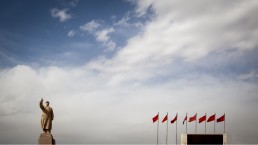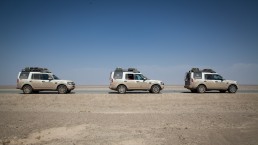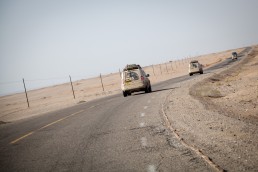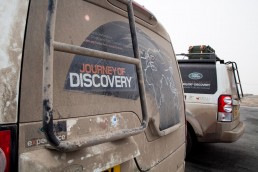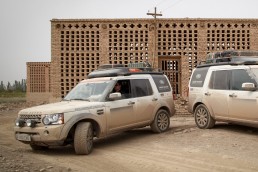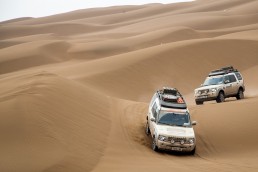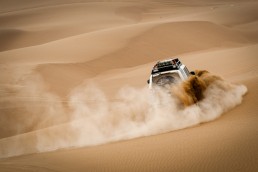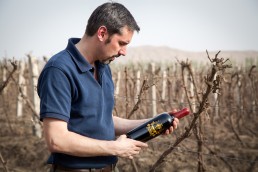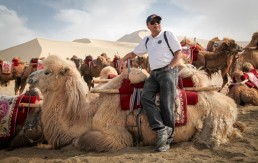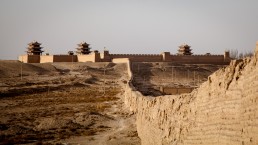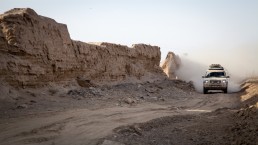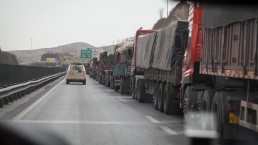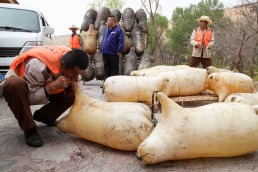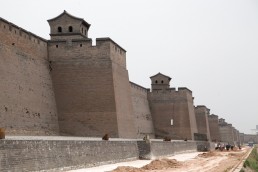In early 2012, the one-millionth Land Rover Discovery trundled off the production line. To celebrate the milestone and to showcase the vehicle’s capabilities, that 'Disco' and three others set off from Jaguar Land Rover's Solihull manufacturing plant near Birmingham in the UK, where the cars are made.
THE GOAL OF THE 50-day “Journey of Discovery” was to negotiate more than 12,000 kilometres of varied terrain across 13 countries, reaching the Chinese capital for the Beijing Motor Show in April.
I was Land Rover’s official writer on the 11-day China leg of the expedition, joining the team in Kashgar, in the Xinjiang Autonomous Region, close to where they crossed the border from Kyrgyzstan.
Working with a photographer and videographer, each day I would write two or three short bulletin posts about the journey. The posts, pictures and video would then be uploaded to Land Rover’s social media, and distributed to traditional media, by support staff in the UK. The carmaker produced a hardback book about the expedition on completion.
The Journey of Discovery raised £1 million for the International Federation of Red Cross and Red Crescent Societies.
For more about the route and places visited on the China leg, which covered some 5,000km, click “More options” at top left of the map. Samples of my bulletins follow. ◉
The route through China, from Kashgar to Beijing.
GMJ-JoD-day36/p1
Red tape in ‘Red China’
One of the world’s largest statues of Mao Zedong towers over the granite expanse of Kashgar’s People’s Square, and the Great Helmsman’s outstretched arm appeared to be waving as the four Land Rover Discoveries set off from Kashi Tianyuan International Hotel this morning.
Today was the Journey of Discovery’s first full day of driving in the People’s Republic of China. Getting into a position to attack the communist country’s roads has proven a serious bureaucratic challenge, with three months of red tape required just to gain permission for the four vehicles to enter “the Middle Kingdom”.
Every other country along the route so far, from the European nations to Kyrgystan, has allowed the team to pass through on our British licence plates. For China, however, we have had to obtain temporary Chinese plates, which we must place between dashboard and windscreen.
Obtaining licence plates is a topical subject in modern China, especially in the major cities — and not just for foreigners passing through. The huge number of cars on China’s roads has prompted authorities to restrict the issuance of city plates in an attempt to reduce congestion and pollution.
In 2011, the capital Beijing issued only 240,000 new plates — one-third of 2010’s total. Requests for Beijing plates topped that number many times over.
With three times the number of would-be car drivers as plates being issued each year, the city of Shanghai now employs an auction system for dishing out plates. In March this year, the average price being paid for a Shanghai licence plate rose to a whopping £5,800.
Personal driving licences have also been an issue for the Journey of Discovery team. Easily available International Driving Permits are not recognised in China — one of only a handful of countries worldwide never to have ratified the 1968 United Nations Conference on Road Traffic.
The solution? Temporary and hurriedly laminated “China Driving Permits” that will expire in a couple of weeks. These, like the China plates, were issued by the authorities only last night. ◉
GMJ-JoD-day37/p1
Skimming the desert
China’s National Road G314 borders the western and northern fringes of the Taklamakan desert. The inhospitable region’s name is probably an amalgamation of Arabic words tark, meaning “to abandon”, and makan, signifying “place”. Taklamakan is popularly and ominously translated, however, as “go in and you’ll never come out”.
The Journey of Discovery team has now been on the G314 for two days, covering about 1,000km (620 miles) between the cities of Kashgar and Korla, with a night’s stopover in Xinjiang’s dusty “cement capital” of Aksu.
The landscape has remained unrelentingly bleak, with endless flat vistas — only occasionally decorated with grey scrub — dissolving disturbingly into the heat haze, and with vegetation-free hills of red rock rising occasionally to the west and north.
When we set off for the Taklamakan, a light drizzle that fell from Kashgar’s brooding sky forewarned of what lie ahead. The rain quickly stained windscreens and coated the vehicles in a mottled ochre film — the rain a particle-heavy solution of Taklamakan sand.
Since then we have encountered minor sandstorms, periods of poor visibility and more than a few whirling dust devils, but also open roads. The majority of the G314 between Aksu and Korla has recently been upgraded to a spanking-new and glass-smooth four-lane highway, allowing our Discovery convoy to reach Korla — and some welcome post-drive sunshine — way ahead of schedule.
Bisected by the Kaidu river and historically another oasis on the Silk Road, Korla played an important role in protecting the ancient trade route from raiding nomads from the north. Today, while it is best known in China for its fragrant pears, Korla is also home to a massive operational centre for PetroChina’s ongoing exploration of the Taklamakan.
The enigmatic desert that the Discoveries have skirted in recent days is home to China’s richest oil and gas fields. ◉
GMJ-JoD-day38/p2
Turpan: celebrating that sinking feeling
The Journey of Discovery team got that sinking feeling today. Literally.
Just four days ago our convoy conquered the Torugart Pass to blast into China from Kyrgyzstan. At about 3,770 metres above sea level, the pass sits at almost three times the height of Ben Nevis, the UK’s highest mountain.
Now we are in Turpan, and while cruising around town the GPS has occasionally registered as low as 50 metres below sea level. That’s an astonishing drop of close to 4km in just a few days. The nearby dried-up Lake Ayding is at a negative 154 metres, making it the third lowest exposed point on the Earth’s surface
The Discoveries made good time in getting to Turpan. The 250-mile drive from Korla took just four hours thanks to another new and silky highway and occasional stretches with 120kph speed limits. Those red-rimmed and circular “120” road signs are always greeted with smiles — they give us a chance to open up a bit and leave the lumbering goods trucks in the dust.
Turpan is another oasis city and it feels good to see green after two days of monochrome desert. Grapes appear to be the local crop of choice with vines growing everywhere.
Notable in the countryside around the town are hundreds, maybe thousands, of unusual box-like buildings. Some are as tall as houses, others squat and elongated. All have walls of latticed brickwork, so that the warm desert winds can blow through.
Investigation reveals that the structures, called chunche in the language of the local Uighurs, are specialist barns used for the drying of grapes. Turpan is the sultana-raisin capital of China, with one local company alone claiming to shift 15,000 tonnes a year.
Note to self: stock up for healthy snacking as we press onward. ◉
GMJ-JoD-day39/p1
Dune-driving in Kumtag Desert Park
This morning we teamed up with the local 4WD-enthusiasts club for a spot of adrenaline-pumping sand-dune driving at Kumtag Desert Park on the edge of the town of Shanshan, about 110km (70 miles) east of Turpan.
The Xinjiang Extreme Rallying Society has about 200 petrol-head members. For those living in the Turpan area, sprawling Kumtag is the recreational stamping ground of choice come weekends.
According to the group’s stocky and friendly leader — who when asked his name insisted, “Just call me ‘The General’” — the Taklamakan is one of the world’s finest off-road driving locations. The annual Taklamakan Desert Auto Rally Race has taken place here every September since 2005.
“It’s a seriously tough competition,” said the General, explaining that the rally takes in terrain ranging from ancient glacier landforms, wind-carved “yadan” canyons and dried-up salt lakes to riverbeds, grasslands and dunes. “The temperature at 7am is a comfortable 20C but by about 2pm the sand temperature can rise to over 60C.”
The 10-day rally, one of the most arduous of its kind in the world, now attracts around 150 cars each year. The cheerily named Beijing Cool Car Time Team was triumphant last year.
To get a taste of the Talklamakan’s challenges, the Discoveries hit the dunes with gusto, and enjoyed a few hours of laughs and thrills, as well as the occasional mishap. Loaded up with heavy expedition kit, tools and spares, each vehicle must be getting on for three tonnes so, unsurprisingly, we got stuck in the soft sand more than once and had to dig ourselves out.
Once the fun was over, the Journey of Discovery team and the Xinjiang Extreme Rallying Society shook hands and we waved our goodbyes. As the General and his gang raced away, throwing up a heavy dust trail, we set about cleaning up.
It was gratifying to note the park’s polite and poetic anti-littering signs at the foot of the dunes. The signs read, “Wind Rushes by Noiselessly. Please Pass by Without a Trace.” ◉
GMJ-JoD-day39/p2
Healing sands in the desert
When the Journey of Discovery’s event director, Jeremy Hart, met up with Professor Momin Abdirahman at the edge of the Taklamakan this afternoon, he looked apprehensive. While Abdirahman is a doctor, the tools of his trade are not sterilised instruments and antibiotics but a simple garden spade and sand. His place of work is not a state-of-the-art clinic but the wide-open desert.
Abdirahman, from nearby Shanshan Uighur Hospital, is a rare practitioner of an ancient healing art. “Sand therapy is a traditional Uighur treatment that has been passed down for 4,000 years,” he explained. “It’s ideal for many ailments, especially aching joints and rheumatoid arthritis, but also skin diseases, male infertility and post-natal depression.”
Wearing a spotless white gown, the man we quickly dubbed “the Sandman” led Jeremy into the undulating dunes. Once a suitable spot had been chosen, the Brit was instructed to prostrate himself on the ground.
The professor took his new patient’s pulse, checked his tongue for … whatever it is they check for, and then set to work with his spade.
Sand therapy is administered in four stages, each in a slightly different desert location: for 15 minutes the feet and lower legs are covered in sand; the entire legs are massaged and then smothered for 30 minutes; the legs and arms are buried for a further half an hour; and finally, only the head protrudes above ground for a full 40 minutes. The Sandman carefully fashioned a tidy sand pillow for Jeremy’s comfort.
“Sand therapy combines the heat from the sun with the healing properties of metallic elements like tin and zinc in the sand,” said Abdirahman, whose hospital treats 500 patients a year with sand therapy. “The best time of the year is mid-June through September because the sand needs to be hot, at least 40C.”
Finally, his treatment over, a dishevelled-looking Jeremy dusted himself down. “I could do that again,” he said, “It’s incredibly relaxing.” But he also offered a word of warning: if you ever try sand therapy yourself, bring SPF 50+ sunblock for your face. ◉
GMJ-JoD-day41/p2
You can take a Frenchman out of France …
We have six more days of intensive driving ahead to reach the Chinese capital for the Beijing Motor Show. Gregory Marc Michel boasts that his truck drivers make the journey in three.
The softly spoken Frenchman is the in-house controller at Turpan Loulan Wine Company, which needs many of those trucks. The Chinese winery produces 5,000 tonnes of wine a year, or 6.65 million bottles.
This afternoon, Gregory ushered us through the company’s state-of-the-art facilities and extensive vineyards — an impressive 100 hectares in total — on the northern rim of the Taklamakan. (He also admitted that his drivers work in threes and in shifts, so that they can keep on the move around the clock.)
The winery’s cave-like entrance is decorated with a mural — a reproduction of a Han Dynasty painting — that suggests China was cultivating grapes for wine as early as the 2nd century AD. The nation has only reinvigorated that tradition in the past two decades.
The results, it must be said, have not seen Bordeaux quaking in its boots, but Gregory is determined to change that, with the region’s favourable weather playing a major role. “There is virtually no rain here, and the water for irrigation comes down fresh from the nearby mountains,” the Frenchman says. “The dryness means few pests and no use of insecticides. Loulan wine is organic almost by accident.”
Loulan’s bestseller comes under the Castle label and incorporates Cabernet Sauvignon and Merlot grapes from vines imported from France 15 years ago. A bottle sells for the equivalent of £60 in China. “Castle is matured in oak barrels for 12 months,” Gregory said. “The result has ripe tannins, good balance and deep colour. Colour is very important to the Chinese people and red means luck.”
Loulan’s vineyards also cultivate a grape varietal called Rouding Xiang that is globally unique. Aromatic and sweet, the grapes are used for a distinctive dessert wine called Loulan Xiang. Only 2,000 bottles are produced a year, each fetching a head-spinning £2,000. ◉
GMJ-JoD-day42/p3
Gala dinner in ancient oasis Dunhuang
It’s been some time since the last camel caravan passed through the ancient Silk Road oasis of Dunhuang. This evening, two modern-day equivalents crossed paths in that flourishing township in the Gobi desert.
Following a pre-sunrise start and 450km (280 miles) of uninterrupted driving from Hami, the Journey of Discovery team made camp in Dunhuang, the Gansu province city that’s home to the Mogao Caves. The complex of 492 grottoes, each carved into cliffs between the 4th and the 14th centuries, are adorned with Buddhist statuary and frescoes.
We’d been invited to join celebrations in Dunhuang marking the successful completion of a second Land Rover expedition in China.
The “Never Stop Discovering” odyssey saw 12 Discoveries travel in convoy from cosmopolitan Shanghai on the country’s eastern seaboard to the high-altitude Tibetan capital of Lhasa. The ambitious journey covered some 8,000km (5,000 miles).
Journalists from more than 70 media outlets from across China — including newspapers, magazines, television stations and new media — attended the shindig, which was held at the foot of Dunhuang’s towering sand dunes. A train of camels plodded along the party’s perimeter. Roaring bonfires illuminated the desert night.
During the gala dinner, video presentations explained the diverse landscapes and peoples experienced by the Never Stop Discovering crew on their journey. They even dragged back folk who had impressed them on their travels, including three young women from Hangzhou who performed live a traditional Chinese tea ceremony, and a dazzlingly dressed minstrel from Lhasa who belted out traditional Tibetan folk songs.
For the Birmingham-to-Beijing gang, highlight of the evening came when team leader Steve Purvis and lead driver Toby Blythe (the only crew member who has been behind the wheel all the way from England) were invited on stage alongside representatives of China’s Land Rover dealerships.
It was unexpectedly announced that the dealers would be making a donation of Rmb2,471,600 to the Journey of Discovery’s cause: the International Federation of Red Cross and Red Crescent Societies.
That’s about £240,000 and not too shabby for an evening’s work. ◉
GMJ-JoD-day43/p2
With Asia’s David Attenborough
A rare treat for the team: we spent the day in the engaging company of Wong How Man, who Time magazine listed in its selection of 25 “Asian Heroes” as “China’s most accomplished living explorer”.
Wong is founder and president of the China Exploration and Research Society (CERS), a non-profit organisation that focuses on exploration and conservation in China’s wildest and most difficult to access locations. Think of an Asian Sir David Attenborough, or a Chinese Sir Ranulph Fiennes.
CERS’ fleet of expedition vehicles consists of nine Land Rovers, so the affable explorer knows what the rugged vehicles are capable of in extreme conditions.
“I imported my own [Land Rover] Defenders in 1993, and since then we’ve been using Land Rovers as our vehicle of delivery to some of the most remote desert terrain in China,” Wong said. “I use Land Rovers because they are by far the most versatile vehicles in terms of carrying capacity, range, off-road capability … all that combines together, and that’s why I made my choice. Of course, I love the look, too.”
Wong took a turn behind the wheel of one of the Discoveries when we visited the Mogao Grottoes this afternoon. “CERS’ Land Rovers — Defender and Discovery vehicles — have been invaluable to our expeditions and conservation work,” Wong said.
Later in the day, the whole team took a detour to Dunhuang’s “singing sand dunes”, so called because of the sound the wind makes when it whips off their slopes. One of the dunes towers 250 metres high.
Posing with a Bactrian camel for team cameras, Wong said: “Between the camel and a modern vehicle like a Land Rover, I can see some parallels. Both can go through some very difficult and rough terrain, like deserts, and even wetlands. This guy, however … in terms of suspension, I’d have to vote for the Land Rover.” ◉
GMJ-JoD-day44/p2
Another brick in the Great Wall
The Journey of Discovery reached a significant milestone with our arrival in Jiayuguan (or Jiayu Pass, literally “Excellent Valley Pass”) in central Gansu province. Jiayuguan, in the Gobi desert, is the most westerly point on China’s iconic Great Wall and a gigantic yellow-stone fort, built in the 14th century during the Ming dynasty, marks the spot.
The ancient military stronghold glistens golden in the setting sun, like something straight out of Beau Geste.
According to legend — and in what might be the first ever recorded example of skilled quantity surveying in action — when the Jiayuguan fortress was being planned, the project foreman asked the designer how many bricks he would need. The designer produced a figure.
The foreman thought that would not be enough, so the designer added one more brick.
When the massive edifice was finally completed, there was one brick left over, which was placed loose on one of the fort’s gates. That brick, it’s said, remains there to this day.
Once back on the road, we travelled eastward through Gansu’s narrow Hexi Corridor — which is basically a string of Silk Road oases along the northern edge of the Tibetan plateau — with the grasslands of Inner Mongolia just over the horizon to our left. Occasional Great Wall watchtowers rising from the sand punctuated the journey.
Think of the Great Wall and it’s likely you’ll envision a structure of crenelated grey stone snaking continuously through rolling green hills. The wall in Gansu is nothing like that.
The wall here was made from a combination of tamped earth, sand, straw and wood. Incredibly, significant sections have survived the centuries remarkably well. The Journey of Discovery will now use it, when the road runs close enough, as our guide.
The Great Wall of China is essentially the thread that will lead us all the way to the capital and the Beijing Motor Show. ◉
GMJ-JoD-day45/p2
Mellow on the Yellow
Worshipped by the Chinese people as the “cradle of civilisation”, the wide and silt-heavy Yellow River has been used for the transportation of people and goods for millennia. Traditionally, such river journeys were made on yangpi fazi, or “leather rafts” that are kept afloat by inflated goatskins.
Always keen for new experiences, this afternoon the Journey of Discovery team decided to put a few rafts through their paces.
We are in the town of Zhongwei, a trendy leisure destination on the edge of the Tengger desert. This is the place in China’s Ningxia Hui Autonomous Region if you fancy racing down a 200-metre sand slope on a wooden toboggan, bungee jumping over the river, or flying across the waterway via a too-high-for-comfort zip wire.
Down on the riverbank we discovered that 14 skins are needed to make a yangpi fazi that can carry as much as a tonne. Rafts can be lashed together to carry heavier loads.
Our friendly oarsmen, who didn’t work too hard and just let the current take us perhaps a mile downstream, explained that the skins are treated with vegetable oil. That way they will last up to three years. What’s more, only male goats are used due to their tougher hides.
Moseying along on the slow-moving river in the sunshine provided a startling contrast to blazing trails on China’s highways. Exchanging the cutting-edge technology of the Discoveries for the primitive joys of yangpi fazi was fun, but not the fastest, smartest or safest way to traverse one of the largest countries on the planet in the 21st century. ◉
GMJ-JoD-day45/p2
Beijing in sight
Tomorrow, the Journey of Discovery will finally enter the Chinese capital Beijing after 46 days on the road. The vehicles will have negotiated 12,000km from Birmingham in the UK, passing through the cosmopolitan capitals of Europe, Russia and the ‘Stans; through dusty deserts and over lofty mountain passes.
Our penultimate day of motoring saw the Discoveries edging into a landscape of rugged hills and greenery. Leaving Ningxia behind and crossing into Shanxi, we drove through a long and drawn-out river valley, with literally thousands of yaodong, or “cave houses”, carved into the slopes to the north.
The history of yaodong goes back centuries and they continue to be used as homes. The region’s compacted yellow earth keeps the interiors warm in winter and as cool as an air-conditioned apartment in summer.
Shanxi possesses about one third of all China’s coal. Around midday, the G20 highway became tremendously busy with coal trucks, until the slow lane — in which the trucks must stay when snarl-ups occur — suffered the longest traffic jam any of us had ever seen. It took the Discoveries 15 minutes to pass the jam at a steady and cautious 60kph — the speed limit on that stretch. That added up to a total distance of 15km (more than nine miles).
Perhaps we should count our blessings. In August 2010, the BBC reported what must be the worst traffic jam of all time, when vehicles north of Beijing locked up for some 100km (about 60 miles), slowing to a crawl for nine whole days, enough time to fly to London and back more than eight times.
We broke for a late lunch in picturesque Pingyao. A Unesco World Heritage Site, Pingyao’s history dates back 2,700 years. Pingyao is one of the best-preserved walled cities in the world.
And now, on our last night on the road, the Journey of Discovery gang is holed up in Taiyuan, Shanxi’s prosperous capital. Restless sleep is expected tonight, and we’ll leave before daybreak come morning. One last push for the prize. ◉
SHARE




